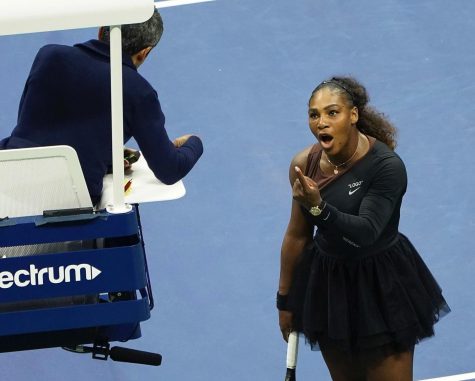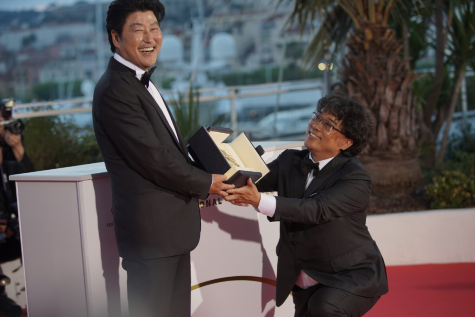Berkeley’s Take on Williams vs Osaka
The Berkeley community reflects on the tennis controversy that sparked conversations about sexism and sportsmanship
It was unanimously thought that Serena Williams would take home another Grand Slam title on Sept. 8th, 2018. However, by the end of the match, the underdog achieved, tempers were lost and accusations of discrimination were thrown. Naomi Osaka won out against longtime fan favorite Serena Williams, making it not only one of the most thrilling of recent tennis matches, but also one of the most controversial. Because of such controversy surrounding a very important sporting event, many Berkeley students had very different opinions regarding it and the Berkeley community as a whole also included the topic in club discussions and student debates.
After the first set, it was clear that Osaka’s abilities reigned superior over Williams, ending in 6-2. Osaka’s idolization of Williams and years of training paid off with her swiftness and clean shots. It should have been an interesting game to watch the 20-year old Osaka battle against one of her heroes. But, as the match progressed, the focus shifted from the match to Williams and the umpire.
The second set began with a code violation from the umpire, Carlos Ramos, for coaching. He had noticed William’s coach, Patrick Mouratoglou, giving hand signals to Williams. Coaching is not allowed during many tennis games, especially in Grand Slam Tournaments. Williams approached Ramos after the code violation and explained how she never saw Mouratoglou’s coaching. After a heated disagreement, Williams returned to the court.
The next violation occurred when Osaka won another game. Williams threw her racket to the ground, smashing it into halves. This prompted Ramos to dock a point from her, which is the penalty for a second violation. Williams then began to argue with Ramos, insisting that he apologize to her for concluding that she had cheated. However, Ramos did not capitulate to her and Williams had to return back to the court again, flustered and upset.
As Osaka continued to win, Williams became more noticeably upset and finally snapped at Ramos, calling him a “thief”. This resulted in Williams obtaining a third violation– a forfeiture of a game that put Williams even further behind Osaka with a score of 5-3.
Osaka finally won with 6-2 in the first set and 6-4 in the second. Cheers subsided and were replaced by boos. Even after the match, everyone had an opinion on the topic. Were umpire Carlos Ramos’ calls sexist or justified? Was Williams demonstrating poor sportsmanship or did she not deserve those violations? Even beyond the tennis world, people were talking. But while the topic may be controversial to many, how did Berkeley students perceive the match?
On Sep 13, the Berkeley Diversity Club held a meeting on sexism in tennis led by Barry Cohen ’19 and Maansi Patel ’19. In the meeting, students discussed and debated sexism in tennis, but even more specifically the events that transpired during the Grand Slam finals. “It (the diversity meeting) was actually a very nice discussion. We all have our different views,” explained Diversity Program Team (DPT) member Annaliese Donaldson-Pham ’21. “So, it was kind of cool to hear the different opinions on both sides.” Other DPT member Sofia Livingstone ’20 who agreed with Donaldson-Pham said, “There were a lot of different ideas. They were all towards the fact that it (Williams’ actions) was wrong but as far as how wrong it was and what they should have done about it, there were a lot of mixed opinions.”
The students deliberated over whether Carlos Ramos’ actions were correct or instead biased towards Williams’ gender. Donaldson-Pham then continued to explain how double standards were discussed during the meeting. “The point came up that a lot of guys break their tennis rackets and they don’t get penalized. But, you also can’t really yell at the umpire after he makes a bad call.” Students also brought up points on how Williams has been the subject of controversy before, with the changes in uniform at the French Open and her losing her temper in previous matches. Like most Diversity Club meetings there were a variety of opinions, beliefs and reasonings but in the end, all of the students could agree that each side had good and respectable points. “Sometimes Diversity meetings will end and people are very tense and stuff, but I feel that with this one, everybody came in with their different views, we all discussed it and we didn’t come out all with the same views, but we had a general understanding of what other people were saying,” said Donaldson-Pham.
When asked whether Williams or Ramos was in the wrong, Rachel Mintz ’21, a player for the Berkeley Varsity tennis team said she could see both sides of the argument. “I felt that she overreacted in some ways, but she was also justified in what she was doing. I believe the umpire was more strict with her than most other players,” Mintz said. She then proceeded to reference Rafael Nadal, another very successful male tennis player from Spain, and the double standards that are shown in competitive tennis. “That same ref has watched Nadal play and Nadel’s coach always coaches him and he (Ramos) has never called him out on it.” Mintz said it’s always against the rules to break one’s racket or coach from the sidelines. However, many coaches will coach their players while they’re playing and while it’s wrong, Williams should have not been penalized for it since many other tennis players, specifically male, often get away with it and Ramos’ actions just exhibited how he could have been out to get her. Finally, she elucidated that Williams should not have been penalized for calling Ramos, a “thief.” “A lot of male players and other players have said worse things and they have not been penalized. They’ve literally cursed on the court and nothing has happened,” Mintz said.
While there is still no clear right or wrong answer surrounding the actions during the match, one thing can be certain. The Williams vs. Osaka match will go down in history and will inspire future conversations about discrimination in competitive sports in the Berkeley community and beyond.

SERENA SHOWING EMOTION In this Saturday, Sept. 8, 2018, file photo, Serena Williams argues with the chair umpire during a match against Naomi Osaka, of Japan, during the women’s finals of the U.S. Open tennis tournament at the USTA Billie Jean King National Tennis Center, in New York. Some black women say Serena Williams’ experience at the U.S. Open final resonates with them. They say they are often forced to watch their tone and words in the workplace in ways that men and other women are not. Otherwise, they say, they risk being branded an “Angry Black Woman.”

REACTING TO HER WIN: Naomi Osaka, of Japan, reacts against Serena Williams during the women’s final of the U.S. Open tennis tournament, Saturday, Sept. 8, 2018, in New York.

HUG IT OUT: Serena Williams hugs Naomi Osaka, of Japan, after Osaka defeated Williams in the women’s final of the U.S. Open tennis tournament, Saturday, Sept. 8, 2018, in New York.

Emma Reilly is a senior who began Berkeley as a 9th grader. She’s a Co-Editor in Chief on The Fanfare who also enjoys being a part of Berkeley’s ATE,...

















